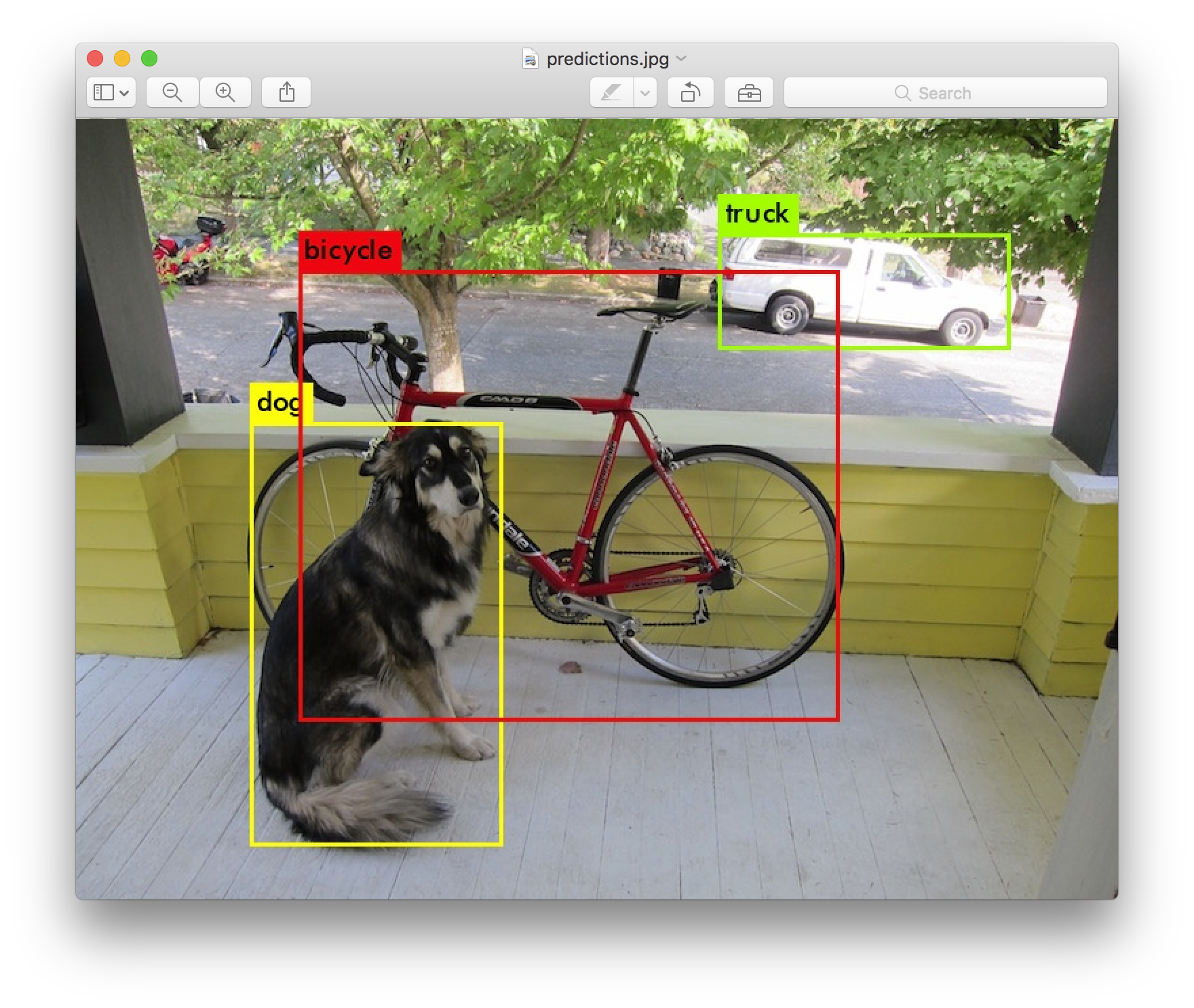coldlarry / Yolov3 Complete Pruning
Labels
Projects that are alternatives of or similar to Yolov3 Complete Pruning
YOLOv3-complete-pruning
本项目以ultralytics/yolov3为YOLOv3的Pytorch实现,并在YOLOv3-model-pruning剪枝的基础上,推出了4个YOLO-v3剪枝版本。(在此致谢两位)
此外,最近还更新了YOLO的1bit、4bit、8bit、16bit量化。
| 剪枝方式 | 优点 | 缺点 |
|---|---|---|
| 正常剪枝 | 不对shortcut剪枝,拥有可观且稳定的压缩率,无需微调。 | 压缩率达不到极致。 |
| 极限剪枝 | 极高的压缩率。 | 需要微调。 |
| 规整剪枝 | 专为硬件部署设计,剪枝后filter个数均为8的倍数,无需微调。 | 为规整牺牲了部分压缩率。 |
| Tiny剪枝 | 稳定的压缩率。 | 由于Tiny本来已很小,压缩率中规中矩。 |
项目特点
1.采用的YOLO-v3实现较为准确,mAP相对较高。
| 模型 | 320 | 416 | 608 |
|---|---|---|---|
YOLOv3 |
51.8 (51.5) | 55.4 (55.3) | 58.2 (57.9) |
YOLOv3-tiny |
29.0 | 32.9 (33.1) | 35.5 |
2.提供对YOLOv3及Tiny的多种剪枝版本、量化版本,以适应不同的需求。
3.剪枝后保存为.weights格式,可在任何框架下继续训练、推理,或以图像视频展示。

4.目前支持情况
| 剪枝方式 | 单卡 | 多卡 |
|---|---|---|
| 正常训练 | √ | √ |
| 稀疏化 | √ | √ |
| 正常剪枝 | √ | √ |
| 规整剪枝 | √ | √ |
| 极限剪枝(shortcut) | √ | √ |
| Tiny剪枝 | √ | √ |
| 二值量化 | 8bit量化 | 16bit量化 | 混合量化 | 任意bit量化 |
|---|---|---|---|---|
| √ | √ | √ | √ | √ |
最新进展
- 2019年12月26日:支持任意bit量化。
- 2019年11月6日:极限剪枝已支持无需微调。
- 非常感谢github大佬tanluren,对该项目指出的众多问题和支持,实在太强了^_^。
环境搭建
1.由于采用ultralytics/yolov3的YOLO实现,环境搭建见ultralytics/yolov3。这里重复介绍一下:
numpytorch >= 1.1.0opencv-pythontqdm
可直接pip3 install -U -r requirements.txt搭建环境,或根据该.txt文件使用conda搭建。
数据获取
依然采用oxford hand数据集

1.下载数据集,并解压至/data目录下,得到hand_dataset文件夹。
2.执行python converter.py ,生成 images、labels 文件夹和 train.txt、valid.txt 文件。
3.获取YOLO预训练权重,/weights文件夹下执行bash download_yolov3_weights.sh,或自行下载。
4.至此,数据部分完成。
剪枝篇
1.正常训练
python3 train.py --data data/oxfordhand.data --batch-size 32 --accumulate 1 --weights weights/yolov3.weights --cfg cfg/yolov3-hand.cfg
2.稀疏化训练
-sr开启稀疏化,--s指定稀疏因子大小,--prune指定稀疏类型。
其中:
--prune 0为正常剪枝和规整剪枝的稀疏化
--prune 1为极限剪枝的稀疏化
--prune 2为Tiny剪枝的稀疏化
python3 train.py --data data/oxfordhand.data --batch-size 32 --accumulate 1 --weights weights/yolov3.weights --cfg cfg/yolov3-hand.cfg -sr --s 0.001 --prune 0
3.模型剪枝
- 正常剪枝
python3 normal_prune.py
- 规整剪枝
python3 regular_prune.py
- 极限剪枝
python3 shortcut_prune.py
- Tiny剪枝
python3 prune_tiny_yolo.py
需要注意的是,这里需要在.py文件内,将opt内的cfg和weights变量指向第2步稀疏化后生成的cfg文件和weights文件。 此外,可通过增大代码中percent的值来获得更大的压缩率。(若稀疏化不到位,且percent值过大,程序会报错。)
量化篇
1 指定需要量化的层
打开任意一个可用的配置文件,例如yolov3-hand.cfg。将需要量化的层,从原来的convolutional替换为quantize_convolutional。
2 指定量化方式
通过修改models.py中的W_bit和A_bit,指定权重的量化方式,激活的量化方式。(目前默认为16bit量化)
3 量化训练
python3 train.py --data data/oxfordhand.data --batch-size 32 --accumulate 1 --weights weights/yolov3.weights --cfg cfg/yolov3-quantize-hand.cfg
与正常训练相同,只是cfg要指向修改过的cfg文件。
推理展示
这里,我们不仅可以使用原始的YOLOV3用来推理展示,还可使用我们剪枝后的模型来推理展示。(修改cfg,weights的指向即可)

python3 detect.py --source ...
- Image:
--source file.jpg - Video:
--source file.mp4 - Directory:
--source dir/ - Webcam:
--source 0 - RTSP stream:
--source rtsp://170.93.143.139/rtplive/470011e600ef003a004ee33696235daa - HTTP stream:
--source http://wmccpinetop.axiscam.net/mjpg/video.mjpg
例如:
python3 detect.py --cfg cfg/prune_0.8_yolov3-hand.cfg --weights weights/yolov3_hand_pruning_percent0.8.weights --data data/oxfordhand.data --source test.jpg
剪枝效果
以下数据除极限剪枝外,均未微调。
YOLO-v3剪枝
| 模型 | 参数量 | 模型体积 | 压缩率 | 耗时 | mAP |
|---|---|---|---|---|---|
| Baseline(416) | 61.5M | 246.4MB | 0% | 11.7ms | 0.7924 |
| 正常剪枝 | 10.9M | 43.9MB | 82.2% | 5.92ms | 0.7712 |
| 规整剪枝 | 15.31M | 61.4MB | 75.1% | 6.01ms | 0.7832 |
| 极限剪枝 | 7.13M | 28.6MB | 88.4% | 5.90ms | 0.7382 |
YOLO-v3-Tiny剪枝
| 模型 | 参数量 | 模型体积 | 压缩率 | 耗时 | mAP |
|---|---|---|---|---|---|
| Baseline(416) | 8.7M | 33.1MB | 0% | 2.2ms | 0.6378 |
| Tiny剪枝 | 4.4M | 16.8MB | 40.1% | 2.0ms | 0.6132 |
量化效果(数据更新中)
以下量化数据中,权重激活均被量化。
YOLO-v3量化
| 模型 | mAP |
|---|---|
| Baseline(416) | 0.8246 |
| 第一层float32+中间层8bit+最后一层float32 | 0.8174 |
| 全16bit量化 | 0.8132 |
| 全8bit量化 | 0.8024 |
核心思想
剪枝方法来源于论文Learning Efficient Convolutional Networks through Network Slimming,剪枝无需微调方法来源于Rethinking the Smaller-Norm-Less-Informative Assumption in Channel Pruning of Convolution Layers。
量化方法来源于论文DoReFa-Net: Training Low Bitwidth Convolutional Neural Networks with Low Bitwidth Gradients。
此外,具体实现时,在论文作者的基础上做了改进。
互动
1.如何获得较高的压缩率?
提高压缩率的关键在于稀疏化训练,可以加大--s的值并迭代训练多次等手段。
2.我的压缩率比表格中更高!
以上数据仅仅是测试了不到20次的结果,如果有同学的压缩率更高,欢迎在评论区分享!
3.程序报错怎么办?
YOLOv3报错
由于采用了ultralytics/yolov3为YOLOv3的Pytorch实现,因此这类错误可跳转至此链接询问。
剪枝量化错误
一定要在本评论区留言,我会尽快修正!
